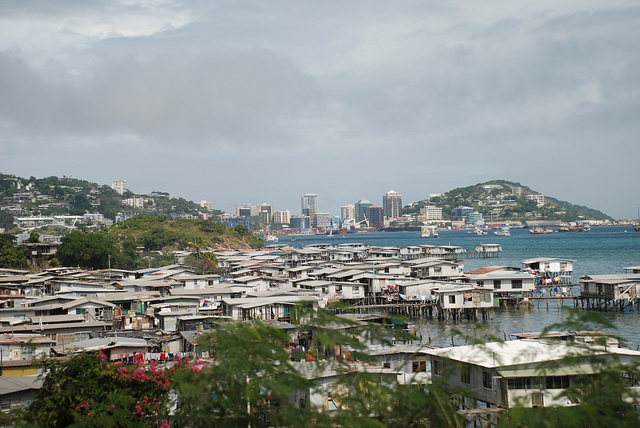
Australia has always been the big fish in our Pacific pond, although we haven’t always lived up to our grand rhetoric of Pacific leadership.
In the recent foreign policy white paper, Australia pledged to step up its support to help create a more resilient Pacific and Timor-Leste. The paper notes that competition for influence in the region is growing, and proposes extending selected Australian government services into the Pacific and giving Pacific islanders access to the Australian labour market.
The white paper says we’ll help to integrate Pacific countries into the Australian and New Zealand economies and into our security institutions. It says, without providing details, that an Australian Pacific Security College will be established. Overall, the paper promises that Australia will bring ‘greater intensity and ambition’ to our approach in the Pacific.
However, the two main island players in the Pacific, Fiji and Papua New Guinea, along with smaller island countries, are forging closer ties with China. Australia is now explicitly expressing concern that China is trying to win favour by funding aid projects, some of little value, in the Pacific.
The foreign policy white paper doesn’t name China specifically; it talks about assistance from ‘other sources’. And it argues that such assistance may ‘undermine regional coordination’ and suggests that countries may have problems absorbing the aid and managing their debts.
But a senior federal government frontbencher made her concerns clear about China’s growing Pacific presence and the way it’s using concessional loans to bolster its influence. The minister for international development and the Pacific, Concetta Fierravanti-Wells, fired a broadside against China, arguing that it was constructing ‘useless buildings’ in the Pacific.
‘We just don’t want to build a road that doesn’t go anywhere. We want to ensure that the infrastructure that you do build is actually productive and is actually going to give some economic benefit or some sort of health benefit’, she said.
Senator Fierravanti-Wells pointed out that on her 24 visits to the region she had come across nations concerned about the use of foreign workers in aid projects. Some countries, she noted, struggle to maintain donated facilities, so they aren’t used to full capacity.
A Chinese foreign ministry spokesman has called the minister’s remarks ‘full of ignorance and prejudice’, adding that Fierravanti-Wells should ‘engage in self-reflection’.
The Lowy Institute estimates that China has provided more than US$1.47 billion in aid to the region since 2006, mainly through concessional loans. The minister is rightly concerned that some Pacific countries are taking on debts they can’t afford to repay.
China emphasises that its Pacific aid is part of mutual assistance between developing countries. It steers away from sensitive areas like good governance to focus on infrastructure projects.
For the most part, the island states’ political leaders are well aware of the benefits and pitfalls of Chinese aid. The efficacy of Chinese aid is mixed across Pacific nations—projects in Samoa and the Cook Islands are more effective than those in Vanuatu and Tonga. Samoa’s prime minister has claimed that Chinese aid has been crucial in his country’s efforts to deal with the impact of climate change. The Tongan justice minister said it was good that his country could work with China as a partner.
China’s loans to countries in the region have an annual interest rate of 2–3% and a repayment period of 15–20 years, including 5–7 years of grace. But it’s unclear what the consequences will be when the islands, which have a high dependence on foreign aid and a real need for foreign investment, have to pay back the loans.
China is encouraging the islands to participate in the One Belt, One Road initiative, which will only strengthen China’s presence in the region.
The Turnbull government’s foreign policy white paper promises that Australia will engage with the Pacific’s ‘outside partners to encourage them to work in a manner that strengthens cooperation, builds more sustainable and resilient economies and maintains stability’.
Australia’s aid budget to the Pacific is over $1 billion, more than a quarter of our total aid budget. The region has been insulated from broader aid cuts.
It makes sense for us, where feasible, to engage with China to improve aid projects. For example, we’ve been conducting a malaria control project with China in PNG since 2016 (China sends technical experts). Nearly 95% of the PNG population lives in areas of high risk for malaria. The disease often affects the most vulnerable and represents a major health and economic burden. China has made huge progress in malaria prevention and control and has accumulated firsthand experience in those fields.
One other obvious area for cooperation is regional law enforcement. It’s not in China’s interest to be tainted with the criminal activities of its citizens abroad, and it’s in the region’s interest that such criminal activities don’t become entrenched. Last August, for example, Fiji deported 77 Chinese online scammers in a joint operation with Chinese law enforcement. Australia should actively seek appropriate avenues for encouraging Chinese participation in regional law enforcement processes. And there may well be other areas of mutual benefit, such as fisheries management.
It’s time to talk with our island neighbours about what might work best for them, to facilitate where we can, and to respect their final decisions—even if we consider that the help comes with strings attached.

